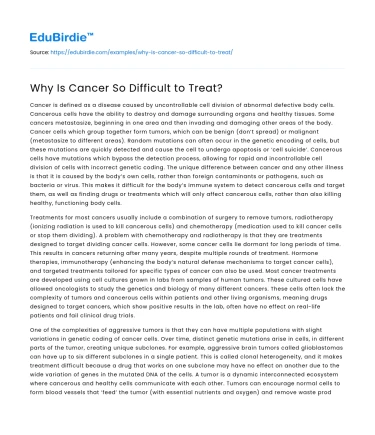Cancer is defined as a disease caused by uncontrollable cell division of abnormal defective body cells. Cancerous cells have the ability to destroy and damage surrounding organs and healthy tissues. Some cancers metastasize, beginning in one area and then invading and damaging other areas of the body. Cancer cells which group together form tumors, which can be benign (don’t spread) or malignant (metastasize to different areas). Random mutations can often occur in the genetic encoding of cells, but these mutations are quickly detected and cause the cell to undergo apoptosis or ‘cell suicide’. Cancerous cells have mutations which bypass the detection process, allowing for rapid and incontrollable cell division of cells with incorrect genetic coding. The unique difference between cancer and any other illness is that it is caused by the body’s own cells, rather than foreign contaminants or pathogens, such as bacteria or virus. This makes it difficult for the body’s immune system to detect cancerous cells and target them, as well as finding drugs or treatments which will only affect cancerous cells, rather than also killing healthy, functioning body cells.
Treatments for most cancers usually include a combination of surgery to remove tumors, radiotherapy (ionizing radiation is used to kill cancerous cells) and chemotherapy (medication used to kill cancer cells or stop them dividing). A problem with chemotherapy and radiotherapy is that they are treatments designed to target dividing cancer cells. However, some cancer cells lie dormant for long periods of time. This results in cancers returning after many years, despite multiple rounds of treatment. Hormone therapies, immunotherapy (enhancing the body’s natural defense mechanisms to target cancer cells), and targeted treatments tailored for specific types of cancer can also be used. Most cancer treatments are developed using cell cultures grown in labs from samples of human tumors. These cultured cells have allowed oncologists to study the genetics and biology of many different cancers. These cells often lack the complexity of tumors and cancerous cells within patients and other living organisms, meaning drugs designed to target cancers, which show positive results in the lab, often have no effect on real-life patients and fail clinical drug trials.
Save your time!
We can take care of your essay
- Proper editing and formatting
- Free revision, title page, and bibliography
- Flexible prices and money-back guarantee
One of the complexities of aggressive tumors is that they can have multiple populations with slight variations in genetic coding of cancer cells. Over time, distinct genetic mutations arise in cells, in different parts of the tumor, creating unique subclones. For example, aggressive brain tumors called glioblastomas can have up to six different subclones in a single patient. This is called clonal heterogeneity, and it makes treatment difficult because a drug that works on one subclone may have no effect on another due to the wide variation of genes in the mutated DNA of the cells. A tumor is a dynamic interconnected ecosystem where cancerous and healthy cells communicate with each other. Tumors can encourage normal cells to form blood vessels that ‘feed’ the tumor (with essential nutrients and oxygen) and remove waste products (such as carbon dioxide). Tumors can also act as immunosuppressants, keeping the immune system from recognizing and destroying the cancer, as well as pathogenic contaminants. Cancer stem cells have given way to a large array of problems also. These cells, although rare, have special properties which have made them resistant to chemo and radiotherapy. In theory, even if the rest of the tumor minimizes beyond detection, during treatment, a single residual cancer stem cell could seed the growth of a new tumor.
Cancer cells are masters of adaptation, with the ability to adjust their molecular and cellular characteristics to survive under stress. When targeted by radiation or chemotherapy, some cancer cells can effectively switch on ‘protective shields’ by changing their gene expression. Cancer is a disease which does not comply with the ‘one size fits all’ method of treatment, meaning different patients require different treatments and even then, the risk of killing all cancer cells is not always absolute. To conclude, much more in-depth research must be conducted in cancer genetics and biology in order to properly understand how to effectively tackle the problem of cancer, which presents itself in more than 200 different forms.
References
- Thallinger, C., Füreder, T., Preusser, M., Heller, G., Müllauer, L., Höller, C., Prosch, H., Frank, N., Swierzewski, R., Berger, W., Jäger, U. and Zielinski, C. (2018). Review of Cancer Treatment with Immune Checkpoint Inhibitors: Current Concepts, Expectations, Limitations and Pitfalls. Wiener klinische Wochenschrift, [online] 130(3–4), pp.85–91. Available at: https://www.ncbi.nlm.nih.gov/pubmed29098404 [Accessed 1 Jan. 2021].
- Jackson, H.J., Rafiq, S. and Brentjens, R.J. (2016). Driving CAR T-cells Forward. Nature Reviews Clinical Oncology, [online] 13(6), pp.370–383. Available at: https://www.nature.com/articlesnrclinonc.2016.36 [Accessed 1 Jan. 2021].
- Garden, H. HowStuffWorks, Health, Conditions, Cancer and Facts, 2021. Why Is It so Difficult To Find Cancer Cells?. [online] HowStuffWorks.
- Wanner, M., 2015. Why Is Cancer so Difficult to Cure?. [online] The Jackson Laboratory.
- nhs.uk. 2019. Cancer. [online].






 Stuck on your essay?
Stuck on your essay?

